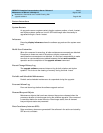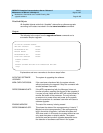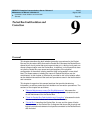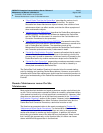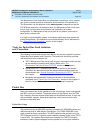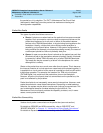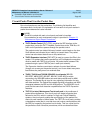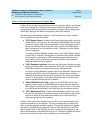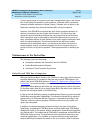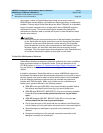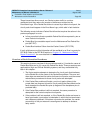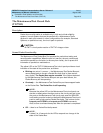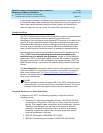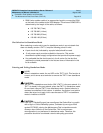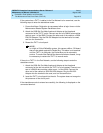
DEFINITY Enterprise Communications Server Release 6
Maintenance for R6vs/si
555-230-127
Issue 1
August 1997
Packet Bus Fault Isolation and Correction
Page 9-6Circuit Packs That Use the Packet Bus
9
Effect of Circuit Pack Failures on the Packet Bus
A failure of any of the circuit packs described in the previous section can disrupt
traffic on the Packet Bus. Some failures cause actual Packet Bus failures with
corresponding alarms, while others cause service outages without alarming the
Packet Bus (although the failed circuit pack(s) should be alarmed).
The following list discusses the effects on the Packet Bus of a failure on each
circuit pack that uses the Packet Bus.
■ TN778 Packet Control. A failure of the Packet Control typically causes all
Packet traffic in the system to fail. As a result, ISDN-BRI sets are not able
to make or receive calls, and communication with an ASAI adjunct fails. A
failure of the Packet Control may also cause a failure of the Packet Bus
itself if the failure is on the interface circuitry. Otherwise, only the Packet
Control is alarmed.
In a High or Critical Reliability system, there is one TN778 Packet Control
in each SPE. If a Packet Control failure in the active SPE causes a Packet
Bus disruption, performing an SPE interchange may restore service. In
some cases, circuit pack failures may require that the circuit pack be
replaced before service is restored.
■ TN570 Expansion Interface. A failure of the Expansion Interface typically
causes all Packet traffic in the connected EPN to fail. If the failure is on the
Packet Bus interface, the Packet Bus may be alarmed as well.
In a High or Critical Reliability system, there is one EPN link in each control
carrier for each EPN. If an active Expansion Interface failure causes a
Packet Bus disruption, performing an Expansion Link switch may restore
service. In some cases, circuit pack failures may require that the circuit
pack be replaced before service is restored.
■ TN556 ISDN-BRI Circuit Pack. A failure of the ISDN-BRI circuit pack
typically causes some or all ISDN-BRI sets and data modules and/or an
ASAI adjunct connected to the circuit pack to fail to function. If the failure
is on the Packet Bus interface, the Packet Bus may be alarmed as well.
■ TN771 Maintenance/Test. A failure of the Maintenance/Test may cause
an incorrect indication of a packet bus failure or the inability to detect such
a failure. A failure of the packet bus interface of the circuit pack may
cause the packet bus to be alarmed.
A failure of the packet bus interface on any of the circuit packs discussed can
cause the packet bus to be alarmed. This is true because such a failure may
result in shorting packet bus leads together. This typically disrupts ALL packet
bus traffic in the affected port network. A failure of the packet bus in the PPN
affects packet traffic in the EPNs as well. Also, packet bus failures that do not
affect all endpoints on that packet bus may occur. Therefore, a packet bus failure
should not be ruled out even if some packet service is still present.



